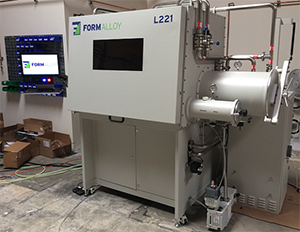Additive Manufacturing: 3D Printer Safety

Learn about hazards of 3D printers.
3D printing uses additive manufacturing technology to help make rapid prototyping and small-scale manufacturing easier and more accessible. With precision computer controls, 3D printers deposit successive layers of material (usually plastic) to create an object. Objects can be of any shape or geometry are produced from a 3D model or from a design fed into the 3D printer by a computer.
This revolutionary process, however, presents hazards to labs. Given the variety of printing mechanisms, it is critical that a hazard evaluation of each unit is done to ensure the suitability of location and safety of users and persons sharing spaces with these devices. Some known hazards related to these devices include:
- Respiratory hazards from exhaust: certain plastics or other materials emit harmful ultrafine particulates or other vapors which must be controlled. Additional local or general exhaust improvements may be required.
- Certain printing materials are inherently hazardous and must be stored in accordance with Fire Code limits and campus policies regarding handling hazardous materials.
- Material classifications may require access to an eyewash or emergency shower if any components are caustic in nature.
Contact the Research Assistance Program prior to purchasing a 3D printer to ensure appropriate safety precautions are taken.
Common Methods
With 3D printing, an object can be made by using the following methods. Each method presents its own hazards that need to be properly evaluated and controlled.
|
Method Name |
Description |
|---|---|
|
Vat Photo-polymerization |
Ultra-violet light is used to hardened containerized photopolymer resins |
|
Material Jetting |
Material droplets are applied through a small-diameter nozzle layer-by-layer, then hardened by UV light |
|
Binder Jetting |
Powder base material and liquid binder (gluing agent) are applied in a “build chamber.” |
|
Material Extrusion |
Thermoplastic filament delivers to a heated nozzle. Nozzle moves in a multi-planar fashion through computer-aided manufacturing software, to deposit the material layers. Filament materials often include acrylonitrile butadiene styrene (ABS) resin, or polylactic acid (PLA) –though other materials may be used. |
|
Powder Bed Fusion/ Laser Sintering |
It uses a high-power laser to fuse small particles of plastic, metal, ceramic or glass powders to form a three-dimensional shape. The laser selectively fuses the powdered materials in cross-sectional layers, layer-by-layer until the object is completed. |
|
Sheet Lamination |
Sheet materials are bound together with external force. Metal sheets are welded by ultrasonic welding, then milled into shape via CNC (computer numerical controlled) device. Paper sheets can be used with adhesive layers, and cut with precision blades. |
|
Directed Energy Deposition |
Predominantly used in high-tech metal industry and rapid manufacturing applications. Similar to electron beam or plasma arc welding, the 3D printing apparatus is attached to a multi-axis robotic arm with a nozzle that deposits metal powder or wire onto a surface, subsequently melted by energy source (electron beam, laser, plasma arc), to form a solid object. |